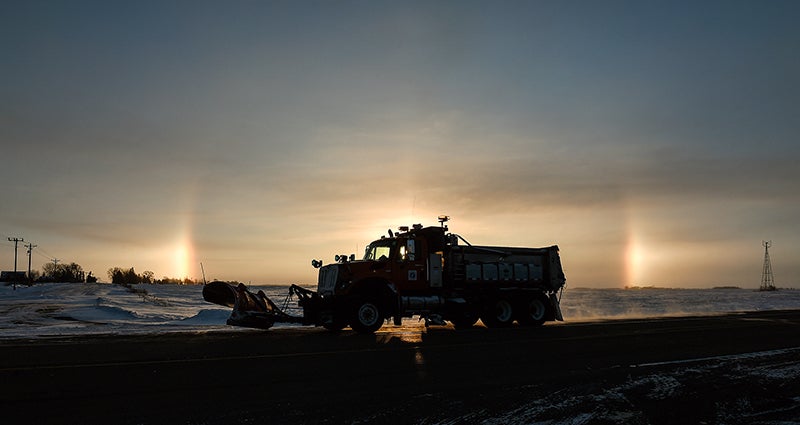The danger is real; Mayo Clinic health experts alerts public about dangers from the extreme cold
Published 9:16 am Wednesday, January 30, 2019

- A MnDot truck heads north on Highway 56 towards Brownsdale and his hugged by sundogs. Eric Johnson/photodesk@austindailyherald.com
Unless necessary, medical experts are advising against extended exposures outside as Minnesota is expected to dip into historic lows on Wednesday.
As much of Minnesota prepared for subzero temperatures, frostbite and hypothermia are the two biggest concerns as residents in Mower County and beyond experience life below zero from Tuesday afternoon through Thursday morning, according to Mayo Clinic emergency medicine experts.
Hypothermia occurs when an individual’s body loses heat faster than it can produce, causing a dangerously low body temperature.
Normal body temperature is about 98.6 Fahrenheit, and hypothermia settles in when the body’s temperature falls below 95 degrees Fahrenheit.
“We haven’t had to deal with (any cases) yet, but the worst is to come,” said Dr. Rhini Singh of Mayo Clinic Health System in Austin. “Luckily, I think we are prepared and we haven’t seen any cases yet.”
When body temperature drops, a person’s heart, nervous system and other organs don’t function properly. If untreated, then hypothermia can lead to complete heart and respiratory system failure, eventually causing death, Singh said. The cause of which comes from exposure to cold weather or immersion in cold water. If you’re indoors, hypothermia can still occur if indoor temperatures are below 50 Farenheit, with increased risk if a person’s also exhausted or dehydrated.
Some symptoms of hypothermia develop slowly and may include:
- Shivering, though this may stop as body temperature drops
- Slurred speech or mumbling
- Slow, shallow breathing
- Weak pulse
- Clumsiness or lack of coordination
- Drowsiness or very low energy
- Confusion or memory loss
- Loss of consciousness
- Bright red, cold skin (in infants)
Someone with hypothermia usually isn’t aware of his or her condition because the symptoms often begin gradually. Also, the confused thinking associated with hypothermia prevents self-awareness. The confused thinking can also lead to risk-taking behavior.
Along with hypothermia, there is also the extreme risk for frostbite if any skin is exposed to the bitter wind chill.
“There are risk factors if there are exposed areas that you didn’t cover,” said Marsha Rosendahl, nurse practitioner. “Tomorrow’s venture for even five minutes can get you frostbite on your fingertips, nose and ears if you’re exposed.”
If wind chill drops below 15 degrees Fahrenheit, frostbite can also set in within 30 minutes, with the most vulnerable areas to frostbite include nose, ears, fingers and toes.
Milder forms of frostbite involves some pain and some numbness, but the skin can change color from red or white, or blue, along with blisters. This can result in serious injury. Worst case scenario would be that the tissue dies and surgery would be required.
Singh recalled a case years ago where a child had “ripped off their tongue” when they licked a piece of extremely cold metal during extreme weather events. She strongly advised individuals to pay attention and not to touch any metal while outdoors if necessary.
“We do recommend definitely to cover the head, the tip of the nose, fingertips and toes,” Rosendahl also added, “If you have any signs of frostbite, remove any wet clothes. … Limit your time outdoors, stay out of the wind and dress in layers of clothing. Make sure you stay hydrated.”
For those traveling, drivers are reminded to take extra precautions to avoid potentially life threatening situations, according to the Minnesota Department of Transportation (MnDOT). Subzero temperatures and strong winds can create wind chills from 40 degrees below zero to 65 degrees below zero Tuesday afternoon through Thursday morning.
The National Weather Service had issued a wind chill warning statewide and most of the Midwest, meaning wind chills are life threatening, and frostbite can occur in as little as five minutes in those conditions. MnDOT’s 101 snowplows in southeast Minnesota will continue to work on the highways, pushing drifts backs and tending to icy patches.
However, motorists should continue to drive slower and keep their headlights on while watching for snow plows, giving them at least 10 car lengths distance. If travel isn’t necessary during the extreme cold periods, it’s advised to stay home, and if travel is necessary, make sure to check car batteries, fuel levels and MnDOT road conditions before traveling.


